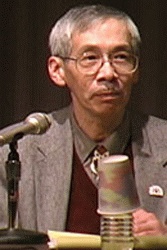|
Tom Richards: Thank you, Representative Kapsner. You’re our first New Native speaker. Sometimes I get the sense that time is marching on. I did some searching on the Internet yesterday; I looked under your married name and then I looked under your maiden name. Mary’s maiden name is Sadler. I knew her father when he was a teacher and a pilot and commercial fishermen up in the Bethel region for a number of years. He’s now the utility manager at Stony River. It’s pretty neat. Well when I did the search for your name under your maiden name, the Tundra Times historical photo Web site popped up and I saw a picture of you as the youth delegate at the 1989 AFN convention.
Representative Mary Kapsner: That’s me.
 |
| Tom Richards |
 |
Tom Richards: We’re speaking to future generations here. We’ll have each of our speakers for approximately half an hour, give them a chance to give an overview of their impressions of ANCSA, their involvement, then I have a few questions. But at about 3:00 o’clock for a period of about an hour, we’ll have everybody here, all the speakers together, and we’ll be taking questions from folks who are here observing. So, if you have any questions that occur to you, please write them down and give them to Dr. Eider or to Professor Blatchford or to Sparky Rowan and we’ll be taking your questions after each of the speakers has had a chance to have their say.
I want to get your impression of a statement that I’ll quote from the Interior Department of 1985 report on ANCSA to Congress. In part, the 1985 report says, “The only way the corporations could benefit their shareholders directly was to give them jobs or pay a regular dividend. To no one’s surprise, the corporations have been able to employ only a small minority of shareholders and, with a few exceptions, have yet to pay regular or substantial dividends,” and then it continues about addressing the issue of New Natives. I’ll talk a little bit about the term “New Natives.” We’re all a little uncomfortable with that. I think in the last session we talked about the alternatives. “New Natives” was settled on as a little bit preferable to the term “After-Borns.”
Representative Mary Kapsner: Yeah, I think so.
Tom Richards: The 1985 study says, “By the time ANCSA corporations are able to establish themselves, it is likely that only a minority of the Alaska Native population will own stock in ANCSA corporations. The proportion of Natives who own stock in ANCSA corporations shrinks every year as the proportion of the Native population born after December 18, 1971 grows. Meanwhile, the proportion of shareholders who are non-Natives increases every year, though by a lesser degree.” Do you ever think that the Calista Region may entertain the options available under the 1991 amendments and allow the young people to become shareholders?
Representative Mary Kapsner: I’m glad that you asked that, and I’ve actually asked that of the leadership within Calista. We have one of the most difficult regions in which to implement something like this, because it’s so large. Our region sees the highest growth rate in the state. My district grew 16 percent within the last census period, within the last 10 years. We have a population bubble and it’s concentrated mostly within the younger ages. In most of the villages that I represent, about half the village is in elementary school. I think it would be difficult to have a corporation where such large numbers of shareholders are not of voting age, or not able to engage themselves in the debate or the policies. In terms of all the corporations, that’s one of the neat things about this—the people who came together on this said our number one priority isn’t greed; it’s taking care of each other. If that means including more and more young people, that’s what it means. I think there’s really a high degree of local control on that; each corporation can decide for themselves. Within Calista, though, that’s going to be a really hard thing to implement.
Tom Richards: Thank you. Our next speaker is also one of the strong proponents of our lecture series. Edward Lee Gorsuch has been chancellor of the University of Alaska Anchorage since July of 1994. Prior to that, between 1988 until 1994, he was Dean of the School of Public Affairs at the University of Alaska Anchorage and oversaw the research, teaching and service activities of the university. From 1976 until 1994, he was director of the Institute of Social and Economic Research. I believe Chancellor Gorsuch became involved with Alaska Native issues while working with Robert Nathan and Associates of Washington, D.C., who were the prime economic consultants to the Alaska Federation of Natives prior to the enactment of ANCSA. After enactment of ANCSA, he came to Alaska and conducted the 2(c) Study of ANCSA. Please welcome Chancellor Gorsuch. I’d like to ask you to begin by discussing a little bit about your involvement with Alaska Native issues and AFN and how you got involved with the 2(c) Study and with Robert Nathan.
|
 |
|




